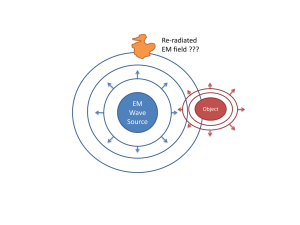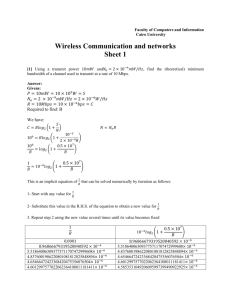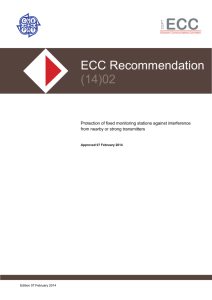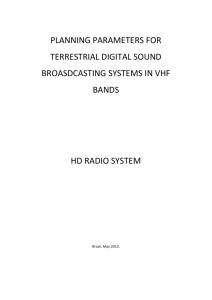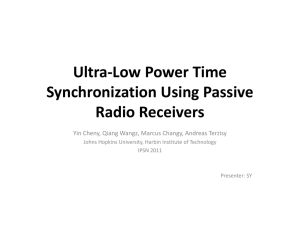Word 2007
advertisement
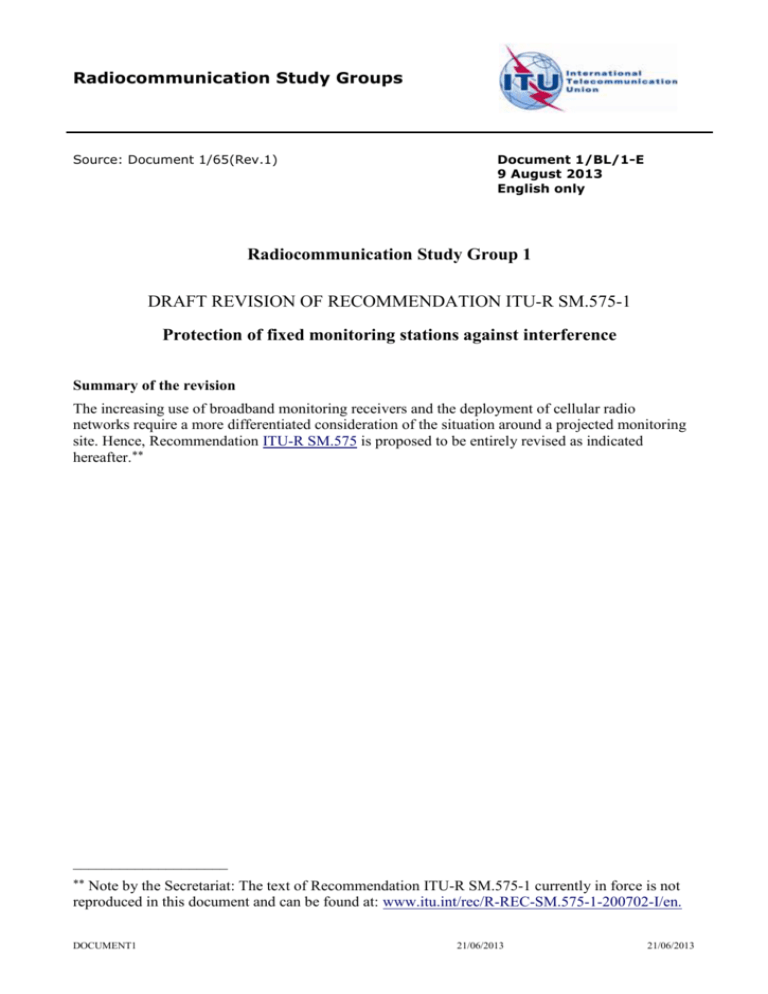
Radiocommunication Study Groups Source: Document 1/65(Rev.1) Document 1/BL/1-E 9 August 2013 English only Radiocommunication Study Group 1 DRAFT REVISION OF RECOMMENDATION ITU-R SM.575-1 Protection of fixed monitoring stations against interference Summary of the revision The increasing use of broadband monitoring receivers and the deployment of cellular radio networks require a more differentiated consideration of the situation around a projected monitoring site. Hence, Recommendation ITU-R SM.575 is proposed to be entirely revised as indicated hereafter.** ____________________ ** Note by the Secretariat: The text of Recommendation ITU-R SM.575-1 currently in force is not reproduced in this document and can be found at: www.itu.int/rec/R-REC-SM.575-1-200702-I/en. DOCUMENT1 21/06/2013 21/06/2013 -21/BL/1-E DRAFT REVISION OF RECOMMENDATION ITU-R SM.575-1 Protection of fixed monitoring stations against interference from nearby or strong transmitters (1982-2007) Scope This Recommendation specifies maximum field-strength levels at monitoring stations to ensure their interference-free operation. The ITU Radiocommunication Assembly, considering a) that reliable and uncorrupted spectrum monitoring information forms a vital part in the spectrum management process; b) that the power radiated from nearby transmitters may result in strong electromagnetic fields at monitoring stations leading to receiver desensitization and blocking effects; c) that these effects in turn may produce false emissions which have to be avoided as far as possible; d) that the deployment of cellular radio and broadcasting stations makes it difficult to find suitable locations for a spectrum monitoring station; e) that the received field strength is an important parameter to determine the suitability of a monitoring site; f) that different frequency ranges require different limitations of the field strength, noting a) that the ITU Handbook on Spectrum Monitoring (Edition 2011) provides general and specific considerations regarding the siting of monitoring stations and a site survey checklist; b) that Report ITU-R SM.2125 describes the measurement procedures to determine the technical parameters of monitoring receivers and monitoring systems, recommends that the method in Annex 1 is used for the calculation of the maximum permissible field strength to protect radio monitoring stations. DOCUMENT1 21/06/2013 21/06/2013 -31/BL/1-E ANNEX 1. Calculation of the maximum permissible field strength to protect radio monitoring stations 1 Introduction Strong RF signals may reduce the ability of a monitoring station to receive weak signals and measure them correctly. The protection of radio monitoring stations against strong RF signals is of particular importance in view of the increasing number of antenna sites for mobile and other radio services. Since monitoring stations are often located in urban areas and exposed spots, it becomes more and more difficult to identify suitable new sites and to protect the existing ones. This Annex describes procedures and calculations for the establishment of protection zones around radio monitoring stations. 2 General considerations The specification of protection criteria for radio monitoring stations primarily involves considering technical aspects and is based on the principle that emissions from adjacent transmitting stations may not cause any interference at the monitoring stations. Although principally there are various possible interfering effects such as sideband emissions, the most severe effect are 3rd order intermodulation products which may be generated in a receiver resulting in fake emissions. This is therefore the only effect considered in this Recommendation. Given certain immunity against strong signals, the occurrence of intermodulation is directly dependant on the input power into the monitoring receiver. It would therefore be easiest to specify a maximum receiver input power that surrounding transmitters may create at the monitoring receiver as a protection criteria. This approach, however, has the disadvantage that the resulting protection distance would depend on the technical properties of the monitoring receiver and antenna which is not known to the operator of a nearby transmitter nor it is equal for all monitoring sites. In addition, it would only provide protection for the current monitoring equipment. Should this be changed in the future (e. g. by installing antennas with different gain), the protection criteria would change leading to a different protection zone. Beside technical aspects, monetary and management aspects are also of high importance. In order to reduce the administrative expenses an uncomplicated and efficient control process needs to be established. An uncomplicated process will be more acceptable to the transmitter operators. For these reasons uniform protection criteria shall apply independent of the location of the monitoring stations and their technical specifications (direction finder or rotatable antenna, type of receiver, antenna gain). This leads to the approach to define a particular field strength that must not be exceeded as the protection criterion. This is also the most transparent approach to other parties involved because the field strength that a transmitter produces at the location of the monitoring station can easily be calculated or measured. The fact whether the maximum field strength actually does produce interference at the monitoring receiver, however, depends on the following parameters: – – – DOCUMENT1 immunity of the receiver against strong signals; sensitivity of the receiver; external noise level; 21/06/2013 21/06/2013 -41/BL/1-E – – – antenna gain; attenuation of the RF cable between antenna and receiver; bandwidth and frequency of the disturbing signal(s). As these parameters may vary within a wide range, a certain defined maximum field strength does not guarantee interference-free operation of the monitoring station under all possible combinations of them. For example, a very sensitive receiver in combination with a high-gain antenna would result in a maximum field strength being so low that no suitable monitoring site could be found within the whole country. The following procedure provides a general method to calculate the maximum permissible field strength. The resulting value for this field strength then depends on the selection of reasonable and typical values for the above parameters. 3 Determination of the maximum permissible field strength The calculation of the maximum agreeable field strength includes: – the immunity (3rd order) of the receiver against strong signals; – the sensitivity of the receiver; – the bandwidth and frequency of the disturbing signal(s); – the gain of the antenna; – the level of external noise. 3.1 Immunity of the receiver against strong signals The level of 3rd order intermodulation products are generally calculated from the input power and the 3rd order intercept point of the monitoring receiver. The most critical combination is the intermodulation of three signals of the same power. According to Recommendation ITU-R SM.1134-1, Table 2, the power of the intermodulation product for our case can be calculated with the formula for IM3(1;1;1) (three signal case). PIM 3 3PS 2PIP 3 6 dB (1) with PIM3 : power of the 3rd order intermodulation product IM3(1;1;1) in dBm; PS : power of each single signal involved in the intermodulation in dBm; PIP3 : 3rd order intercept point (IP3) of the receiver in dBm. The value of IP3 can be taken from the receiver specification sheet. It is the power of the input signals at the point where the level of the 3rd order intermodulation product is equal to the input level of the strong signals contributing to this intermodulation. 3.2 Receiver sensitivity A weak signal can be detected with a receiver when its level exceeds the internal noise of the receiver. This is the indicated level when no antenna is connected and the receiver is operated in its most sensitive mode (e. g. no input attenuation). The Root-Mean-Square value of the internal noise of a receiver is generally calculated by p R ( f 1)kt0 Bn ( f 1) pn Bn (2) with DOCUMENT1 21/06/2013 21/06/2013 -51/BL/1-E f : noise factor of the receiver; k : Boltzmann‘s constant; t 0 : reference temperature taken as 290 K; Bn : noise bandwidth of the receiver; pn kt0 : available thermal noise power (W) in 1 Hz bandwidth. The sensitivity of a receiver is characterized in data sheets with noise figure NF. Thus equation (2) can be written as the following. p R (10 with NF 10 1) p n Bn (3) NF = 10 log (f) : receiver noise figure in dB Written in dBm the r.m.s. value of the receiver’s internal noise becomes: PR (dBm ) 10 log( 10 NF 10 1) 10 log( Bn ) 174(dBm ) (4) with –174 dBm: available thermal noise power at room temperature in 1 Hz bandwidth Usually the measurement bandwidth of a receiver is about equal to its noise bandwidth. In addition, noise figures (NF) of typical monitoring receivers have values of 10 dB or larger. Taking this in account, the formula of the r.m.s. value of the receiver’s internal noise becomes less complex: PR (dBm ) Pn NF 10 log( B) (5) with Pn : available thermal noise power at room temperature in 1 Hz bandwidth (–174 dBm); B : measurement bandwidth in Hz. The value of the noise figure can be taken from the receiver specification sheet. The parameter PR is also known as “displayed average noise level” (DANL). 3.3 Receiver bandwidth Whenever specifying levels of RF signals, the reference bandwidth used to measure this level also has to be specified. Without further information, the maximum field strength to protect a monitoring station would normally be measured in the total bandwidth of the respective signal. 3.4 Antenna gain To convert measured input levels into field strength it is important to know the properties of the antenna. The antenna gain is connected to the antenna factor according to Gi 20 log( f ) k 30dB (6) with Gi: antenna gain in the direction of the main beam in dBi; f: frequency in MHz; k : antenna factor in dB/m. DOCUMENT1 21/06/2013 21/06/2013 -61/BL/1-E The antenna factor may be used to calculate the field strength from the voltage at the antenna connector according to E U k (7) with E : electrical field strength in dBµV/m; U : voltage at the antenna output in dBµV. The values for the antenna factor and/or antenna gain can be taken from the antenna specification sheet. For 50 Ohm systems, RF power and RF voltage are connected through P[dBm ] U [dBµV ] 107dB (8) E[dBµV / m] P[dBm] 20 log( f [MHz ]) Gi [dB] 77dB (9) So that 3.5 External noise External noise in this context is the level of all unwanted emissions, whether man-made or natural, that the monitoring receiver gets from the antenna. For frequencies above about 30 MHz, the main component is man-made noise (MMN). However, the level of the MMN is in most cases lower than the receiver noise level, especially in rural areas and can therefore be neglected in the calculation process. For frequencies below 30 MHz, however, the sensitivity of the monitoring setup is determined by the external noise rather than the receiver noise. The actual level of the external noise is strongly dependant on the location of the monitoring station and even on the time of day. Furthermore the sky wave propagation of signals below 30 MHz usually results in the strongest signals received being foreign AM broadcast stations. Although the reception level of these stations may be so high that monitoring performance is considerably decreased, the monitoring administration has no legal influence on the presence of these signals. Moreover, they are present at any possible monitoring location. Therefore it seems not sensible to calculate protection field strengths for frequencies below 30 MHz. The following calculation is valid only for frequencies above 30 MHz where external noise is not dominant. 3.6 Calculation process For the calculation of the power of the 3rd order intermodulation product IM3 we presume the case that a total number of three signals of equal power and bandwidth interact in the receiver’s input circuit. The bandwidth of an intermodulation product from three signals is three times the signal bandwidth Bs. It is not easy to determine the bandwidth of an intermodulation product when real signals interact (e.g. DVB-T or LTE). Usually these spectrums have no significant minimums and maximums. Thus, it is possible to presume, without making great error, that the spectrum of this intermodulation product is rectangular. DOCUMENT1 21/06/2013 21/06/2013 -71/BL/1-E The part of the power ∆PIM3 of the intermodulation product measured in the bandwidth B can be calculated by B PIM 3 (dBm ) PIM 3 10 log 3B S (10) Using formula (1) this term becomes B PIM 3 (dBm ) 3PS 2PIP 3 6dB 10 log 3B S 3PS 2PIP 3 6dB 10 log( B) 10 log( 3BS ) (11) Interference due to IM products begin to be visible when the level ∆PIM3 exceeds the receiver noise floor: PIM 3 PR . (12) The “critical” point where this situation occurs can be calculated using formulas (5) and (11) as follows: 3PS 2PIP3 6dB 10 log( B) 10 log( 3BS ) NF 10 log( B) 174dBm (13) PS 2PIP 3 NF 10 log( BS ) 10 log( 3) 6dB 174dB 3 (14) PS 2PIP 3 NF 10 log( BS ) 58.4dBm . 3 (15) Assuming no considerable cable attenuation between antenna and receiver, the field strength corresponding to PS can be calculated using formula (9) as follows: Emax (dBµV / m) 3.7 2PIP 3 (dBm) NF (dB) 10 log BS ( Hz ) 20 log f (MHz ) Gi (dB) 18.6dB 3 (16) Interference effect of a larger number of stations Formula (16) already reveals the maximum permissible field strength of every single disturbing transmitter that maybe involved in a possible intermodulation product. If more than three transmitters are received with this maximum field strength, the only effect will be that additional intermodulation products will show up at different frequencies, but the level of each of the intermodulation products will not rise. Therefore additional adaption of the maximum permissible field strength values is not necessary. DOCUMENT1 21/06/2013 21/06/2013 -81/BL/1-E 4 Typical parameter values To get a numerical value for the maximum permissible field strength from formula (16), realistic values for the parameters receiver noise figure, 3rd order intercept point, reference bandwidth and antenna gain have to be chosen. This section provides guidance on how to select these values. 4.1 Receiver noise figure Noise figures of monitoring receivers and spectrum analyzers are often in the range between 7 and 24 dB. The overall noise figure of the measurement setup may be improved even down to 1 dB by using external low noise amplifiers (LNA), but for a fixed monitoring station, this is not a typical configuration. Assuming built-in preamplifiers, a typical noise figure around 10 dB is suggested to be used when calculating the maximum permissible field strength in the context of this Recommendation. 4.2 IP3 IP3 levels of monitoring receivers and spectrum analyzers are often in the range between +10 and +30 dBm. A value of +15 dBm may be regarded as typical although special digital wideband receivers with no preselection at all and poor dynamic range may have lower IP3 levels. 4.3 Signal bandwidth When measuring weak signals, the highest S/N would be achieved when using the narrowest possible measurement bandwidth because this would result in the lowest possible DANL. This, however, is only true for unmodulated carriers. When measuring digital signals, for example, narrower measurement bandwidths do not increase the signal-to-noise ratio (S/N) and hence would not increase measurement sensitivity. Also the IM products interfering with a measurement are not unmodulated carriers. They have a bandwidth even wider than the strong signals involved, so that their interference potential does not increase when using a measurement bandwidth that is narrower than the signal bandwidth. It is therefore recommended to specify a typical signal bandwidth in the respective frequency band when calculating the maximum field strength to protect the monitoring station. 4.4 Antenna gain A tuned dipole antenna has a gain of 2.15 dBi. Many monitoring antennas are omnidirectional and have no higher gain. Also the antennas used in direction finders may usually be regarded as having gain of dipoles. However, many monitoring stations are also equipped with directional antennas. The gain of these antennas would in turn decrease the permissible field strength. Nevertheless it is recommended to assume a dipole antenna in the calculation of maximum permissible field strength for the following reasons: – – – DOCUMENT1 considering directive antennas would lead to a permissible field strength depending on the monitoring equipment which was intended to be avoided (see section 2) for the benefit of transparent, uniform field strength limits; intermodulation products as considered here always involve at least two strong signals. Calculating with the gain of a directive antenna in its main beam assumes that all strong signals are received from the same direction which is not always realistic and overestimates the interference potential; possible interference due to increased signal level with directive antennas would only be effective in a certain direction while in all other directions the field strength and hence interference potential is even lower than with omnidirectional antennas. 21/06/2013 21/06/2013 -91/BL/1-E It should be noted that the use of high gain directional antennas may result in interfering effects in certain directions due to field strength levels higher than calculated when assuming omnidirectional antennas. If these effects cannot be tolerated, band stop filters or attenuators may be inserted to prevent incorrect measurements. 5 Example calculation using typical values This section provides a calculation example using the typical parameter values suggested in section 4. Looking at formula (16) and considering the different reference bandwidths, it is obvious that the resulting maximum field strength will be frequency-dependant. For the GSM frequency range around 950 MHz, for example, formula (16) yields Emax [dBµV / m] 2 * 15dBm 10dB 10 log( 250,000 Hz ) 20 log( 950MHz ) 2.15dB 18.6dB 3 107.3dBµV / m ______________ DOCUMENT1 21/06/2013 21/06/2013

